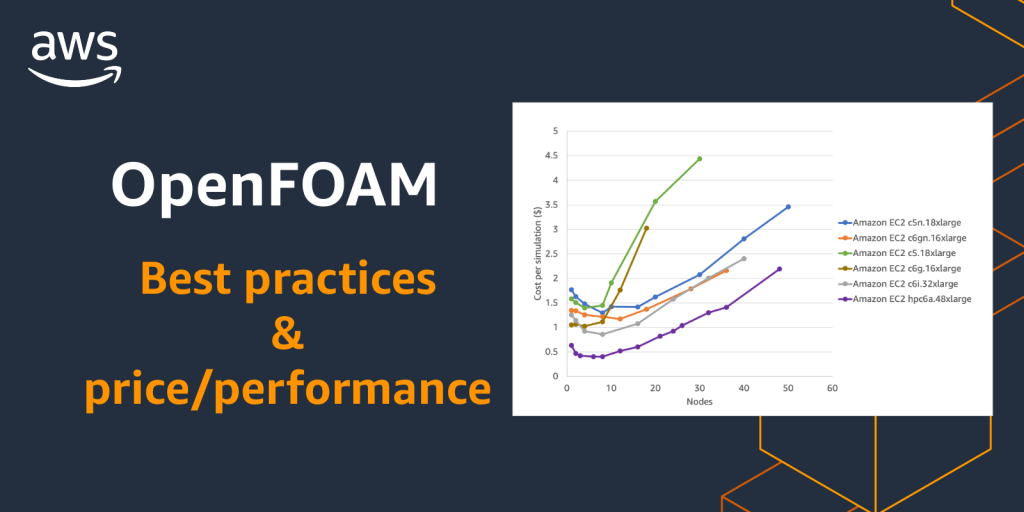AWS HPC Blog
Category: *Post Types
Getting the best OpenFOAM Performance on AWS
OpenFOAM is one the most widely used Computational Fluid Dynamics (CFD) packages and helps companies in a broad range of sectors (automotive, aerospace, energy, and life-sciences) to conduct research and design new products. In this post, we’ll discuss six practical things you can do as an OpenFOAM user to run your simulations faster and more cost effectively.
Cloud-native, high throughput grid computing using the AWS HTC-Grid solution
We worked with our financial services customers to develop an open-source, scalable, cloud-native, high throughput computing solution on AWS — AWS HTC-Grid. HTC-Grid allows you to submit large volumes of short and long running tasks and scale environments dynamically. In this first blog of a two-part series, we describe the structure of HTC-Grid and its objective to provide a configurable blueprint for HPC grid scheduling on the cloud.
Optimize your Monte Carlo simulations using AWS Batch
Introduction Monte Carlo methods are a class of methods based on the idea of sampling to study mathematical problems for which analytical solutions may be unavailable. The basic idea is to create samples through repeated simulations that can be used to derive approximations about a quantity we’re interested in, and its probability distribution. In this […]
Integrating OKTA identity service provider with NICE EnginFrame
This post by Roberto Meda and Salvo Maccarone covers how you can configure NICE EnginFrame to leverage OKTA as an identity service provider to support SAML 2.0 single sign on authentication and several other features like multi-factor verification, API access management and multi-device support.
How to Arm a world-leading forecast model with AWS Graviton and Lambda
The Met Office is the UK’s National Meteorological Service, providing 24×7 world-renowned scientific excellence in weather, climate and environmental forecasts and severe weather warnings for the protection of life and property. They provide forecasts and guidance for the public, to our government and defence colleagues as well as the private sector. As an example, if you’ve been on a plane over Europe, Middle East, or Africa; that plane took off because the Met Office (as one of two World Aviation Forecast Centres) provided a forecast. This article explains one of the ways they use AWS to collect these observations, which has freed them to focus more on top quality delivery for their customers.
Join us for our HPC “Speeds n’ Feeds” event on Feb. 9
It’s often difficult to keep track of all the announcements AWS is making around HPC. Come and join us on Feb. 9th for a quick overview of the latest and greatest AWS HPC products and services launched over the past year. You will hear directly from the AWS HPC engineers and product managers who have built these exciting new offerings.
Running Windows HPC Workloads using HPC Pack in AWS
This blog post shows you how to deploy an HPC cluster for Windows workloads. We have provided an AWS CloudFormation template that automates the creation process to deploy an HPC Pack 2019 Windows cluster. This will help you get started quickly to run Windows-based HPC workloads, while leveraging highly scalable, resilient, and secure AWS infrastructure. As an example, we show how to run a sample parametric sweep for EnergyPlus, an open source energy simulation tool maintained by the U.S. Department of Energy’s Building Technology Office.
Accelerating drug discovery with Amazon EC2 Spot Instances
We have been working with a team of researchers at the Max Planck Institute, helping them adopt the AWS cloud for drug research applications in the pharmaceutical industry. In this post, we’ll focus on how the team at Max Planck obtained thousands of EC2 Spot Instances spread across multiple AWS Regions for running their compute intensive simulations in a cost-effective manner, and how their solution will be enhanced further using the new Spot Placement Score API.
Introducing AWS HPC Connector for NICE EnginFrame
Today we’re introducing AWS HPC Connector, a new feature in NICE EnginFrame that allows customers to leverage managed HPC resources on AWS. With this release, EnginFrame provides a unified interface for administrators to make hybrid HPC resources available to their users both on-premises and within AWS. In this post, we’ll provide some context around EnginFrame’s typical use cases, and show how you can use AWS HPC Connector to stand up HPC compute resources on AWS.
How we enabled uncompressed live video with CDI over EFA
We’re going to take you into the world of broadcast video, and explain how it led to us announcing today the general availability of EFA on smaller instance sizes. For a range of applications, this is going to save customers a lot of money because they no longer need to use the biggest instances in each instance family to get HPC-style network performance. But the story of how we got there involves our Elastic Fabric Adapter (EFA), some difficult problems presented to us by customers in the entertainment industry, and an invention called the Cloud Digital Interface (CDI). And it started not very far from Hollywood.






